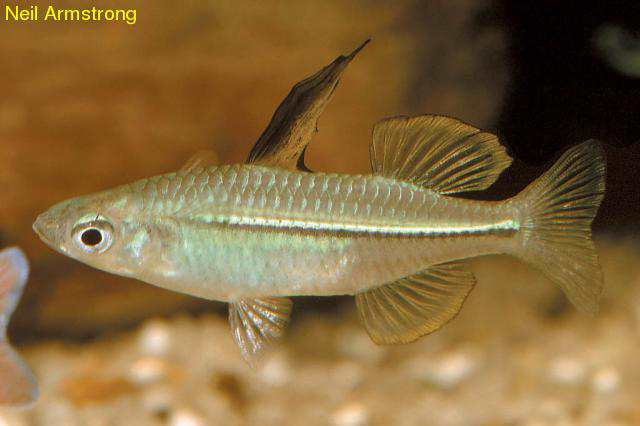Blackmast, Craterocephalus stramineus (Whitley 1950)

Blackmast, Craterocephalus stramineus. Source: Neil Armstrong. License: All rights reserved
Blackmast in the Finniss River near Batchelor in the Northern Territory.
Blackmast, Craterocephalus stramineus (Whitley 1950)
More Info
|
Distribution |
Known only from the Ord River drainage, WA (128º33´E) to the Katherine River, NT and Gregory River, QLD (139º15´E). A tropical species inhabiting freshwater streams and lake margins with aquatic plants, often forming moderately sized shoals near the surface. |
|
Features |
Dorsal fin VI-VII + I, 9-10; Anal fin I, 10-11; Pectoral fin 13-14; Vertebrae 33 Body compressed, robust; greatest body depth 2.9-3.2 in SL; mouth small, oblique, protractile; rear edge of jaw not reaching eye; ventral profile more convex than dorsal; one or more rows of strong teeth on outside of mouth; front of each jaw with a single series of pointed, slightly movable; vomer without teeth; nostrils small, oval. Body covered by cycloid, slightly crenulated scales; vertical scale rows 27-31; scales present on head. Two separate dorsal fins; 1st dorsal fin tall, much higher than 2nd; 1st dorsal fin with seven long flexible spines, its origin behind level of origin of ventrals, before level of vent, and much nearer snout than root of caudal; 2nd dorsal with one short spine preceding the branched rays, its origin behind level of that of anal; anal fin with 1 feeble spine and eleven branched rays; 2nd dorsal and anal rounded, not elevated anteriorly as in Pseudomugil; pectoral small, the third ray longest; caudal fin forked. |
|
Size |
To 6.5cm SL, commonly to 4cm. |
|
Colour |
Semi-transparent with a pale yellowish hue; adults with a bright yellow ventral surface; mid-lateral stripe edged with silver or blue; fins mostly clear but front section of 1st dorsal fin black and outer edge of 2nd dorsal fin and anal fin yellow. |
|
Feeding |
Omnivorous, feeding on small invertebrates and algae. |
|
Biology |
Pair spawning with a few eggs deposited into the vegetation each day. Eggs with adhesive filaments. Larvae hatch after 7-9 days. |
|
Fisheries |
|
|
Conservation |
|
|
Remarks |
Populations may fluctuate throughout the year becoming more abundant during the wet season when conditions are more favourable. |
|
Similar Species |
Easily distinguished from other species in the genus Craterocephalus by the tall first dorsal fin with its black leading edge. |
|
Etymology |
The specific name stramineus is from Latin and means 'straw' in reference to the yellowish colouration. |
|
Species Citation |
Quiris stramineus Whitley, 1950, Rec. Aust. Mus. 22(3): 239 fig. 3. Type locality: Katherine River, NT. |
|
Author |
Vanessa J. Thompson |
Blackmast, Craterocephalus stramineus (Whitley 1950)
References
Allen, G.R. & Leggett, R. (1990). A collection of freshwater fishes from the Kimberley region of Western Australia. Rec. West. Aust. Mus. 14(4): 527–545
Allen, G.R., Midgley, S.H. & Allen, M. (2002). Field guide to the freshwater fishes of Australia. Perth : Western Australian Museum 394 pp.
Crowley, L.E.L.M. & Ivantsoff, W. (1992). Redefinition of the freshwater fish genus Craterocephalus (Teleostei: Atherinidae) of Australia and New Guinea with an analysis of three species. Ichthyol. Explor. Freshw. 3(3): 273–287 [283]
Larson, H.K. & Martin, K.C. (1990). Freshwater Fishes of the Northern Territory. Northern Territory Museum of Arts and Sciences Handbook Series Number 1. Darwin : Northern Territory Museum of Arts and Sciences 102 pp. (as Quirichthys stramineus)
Leggett, R. & Merrick, J.R. (1987). Australian Native Fishes for Aquariums. Artarmon : J.R. Merrick Publications 241 pp. (as Quirichthys stramineus)
Merrick, J.R. & Schmida, G.E. (1984). Australian Freshwater Fishes Biology and Management. Sydney : J.R. Merrick 409 pp.
Whitley, G.P. (1950). Studies in Ichthyology No. 14. Rec. Aust. Mus. 22(3): 234–245 figs 1–5 pl. 17



